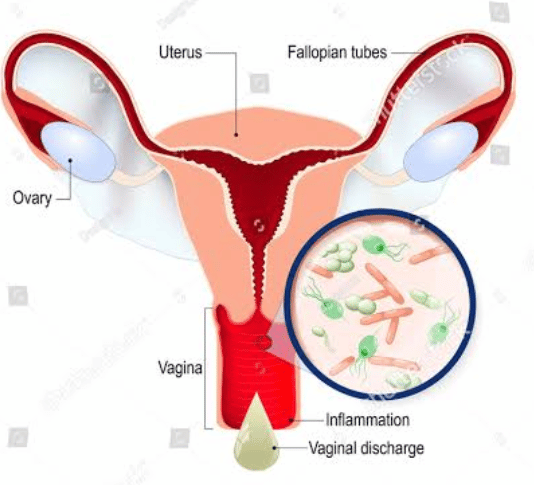Vaginitis is an inflammation of the vagina. It normally results from an infection. The patient typically has a discharge, itching, burning, and possibly pain.
It is a common condition, and most women will have it at least once at some time in their life.
The vagina is the muscular canal that runs from the cervix to the outside of the body, lined by a mucus membrane. It has an average length of about 6 to 7 inches.
The only part of the vagina that is normally visible from the outside is the vaginal opening.
Symptoms
The most common symptoms of vaginitis include:
- irritation of the genital area
- discharge that may be white, gray, watery, or foamy
- inflammation, leading to redness and swelling of the labia majora, labia minora, and perineal area, mainly due to an excess of immune cells
- dysuria, which is pain or discomfort when urinating
- painful sexual intercourse, known as dyspareunia
- foul or fishy vaginal odor
Causes
Infection is the most common cause of vaginitis, including candidiasis, bacterial vaginosis, and trichomoniasis. After puberty, infectious vaginitis accounts for 90 percent of cases.
Less commonly, vaginitis may also be caused by gonorrhea, Chlamydia, mycoplasma, herpes, campylobacter, some parasites, and poor hygiene.
Vaginitis can occur before puberty, but different types of bacteria may be involved. Before puberty, Streptococcus spp is a more likely cause, sometimes because improper hygiene practices spread bacteria from the anal area to the genitals.
The proximity of the vagina to the anus, lack of estrogen, lack of pubic hair, and lack of labial fat pads may increase the risk of vulvovaginitis in before puberty. Vulvovaginitis is an inflammation of the vagina and vulva. It can affect women of all ages.
After puberty, infection is most often due to Gardnerella.
Sometimes, vaginitis can stem from an allergic reaction, for example, to condoms, spermicides, certain soaps and perfumes, douches, topical medications, lubricants, and even semen.
Irritation from a tampon can also cause vaginitis in some women.
Factors that increase the risk of vaginitis include:
- pregnancy
- douching and using vaginal products, such as sprays, spermicides, and birth control devices
- using antibiotics
- wearing tight pants or damp underwear
- low estrogen levels during menopause. Women with diabetes are particularly prone to vaginitis.
Transmission
Sexual intercourse is the most common means of transmission for vaginitis, but it is not the only means.
Some experts believe that having multiple sexual partners can increase the risk of bacterial vaginosis, which is a particular type of vaginitis. Having a female sexual partner could also increase the risk of developing bacterial vaginosis by 60 percent.
Healthcare professionals sometimes call yeast infections and bacterial infections sexually associated infections.
People who are sexually active tend to contract them more frequently. However, infections are not necessarily passed from one partner to another during sexual intercourse.
Types
There are several types of vaginitis, depending on the cause.
The most common are:
- Atrophic vaginitis: The endothelium, or lining of the vagina, gets thinner when estrogen levels decrease during the menopause, making it more prone to irritation and inflammation.
- Bacterial vaginosis: This results from an overgrowth of normal bacteria in the vagina. Patients usually have low levels of a normal vaginal bacteria called lactobacilli.
- Trichomonas vaginalis: Sometimes referred to as trich, it is caused by a sexually transmitted, single-celled protozoan parasite, Trichomonas vaginalis. It may infect other parts of the urogenital tract, including the urethra, where urine leaves the body.
- Candida albicans: A yeast that causes a fungal infection, known as vaginal thrush. Candida exists in small amounts in the gut and is normally kept in check by normal gut bacteria.
ADVERTISEMENT
Looking to discreetly treat Bacterial Vaginosis?
Diagnosis
The doctor will carry out a physical examination and ask about medical history, particuarly regarding any previous sexually transmitted infections.
The doctor may conduct a pelvic exam to check inside the vagina for inflammation and excess discharge. A sample of discharge is sometimes taken in an attempt to determine the cause of the inflammation.
The cause of vaginitis may be diagnosed by checking the appearance of the vaginal fluid, vaginal pH levels, the presence of volatile amines (the gas that causes a bad smell), and the microscopic detection of specific cells.
Treatment
Treatment depends on the cause. It may include low-potency topical steroids, applied to the skin, topical or oral antibiotics, antifungals, or antibacterial creams.
Bacterial vaginitis (BV) is usually treated with natural antibiotics, such as metronidazole (Flagyl), or clindamycin.
Medications used to treat a fungal infection include butoconazole and clotrimazole.
Other options include:
- Cortisone cream to treat severe irritation.
- Antihistamines, if the inflammation appears to stem from an allergic reaction.
- Topical estrogen cream, if the vaginitis is due to low estrogen levels.
If a woman is pregnant, she should make sure her doctor knows, because vaginitis can affect the fetus, and because some treatment options may not be suitable.
Prevention
The following best practices may help prevent vaginitis:
- having good overall hygiene
- using mild soaps without irritants or scents
- wearing cotton underwear
- avoiding douching and irritating agents, such as those present in hygiene sprays, soaps, and other feminine products
- wiping from front to back to avoid spreading bacteria from the anus to the vagina
- wearing loose-fitting clothing
- practicing sex with a condom
- using antibiotics only when necessary
Outlook
It is common for most women to have vaginitis at least once in their life, and it is rarely dangerous.
Completing a course of doctor-prescribed antibiotics will typically remove any infections and ease the related inflammation.
Not having sex and avoiding vaginal products containing potential irritants for several few days after diagnosis may also speed up recovery.

